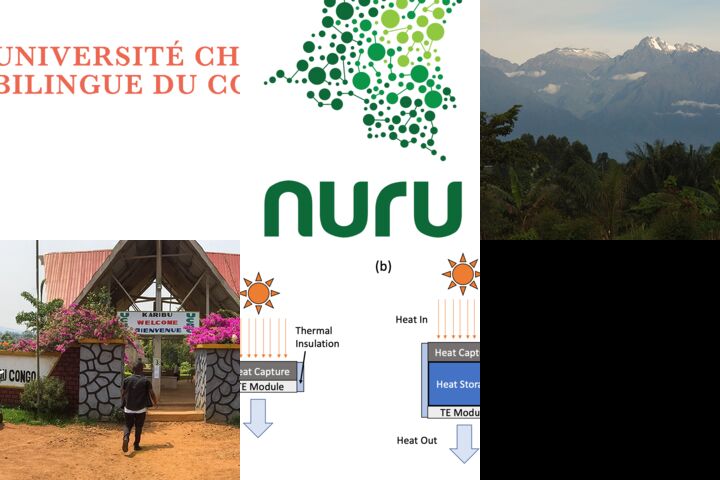Thermoelectric green energy
The Problem
Charcoal production in eastern Democratic Republic of Congo is affecting the habitat of many animals that are found nowhere else in the world including the endangered mountain gorilla that lives nowhere other than eastern Congo's Virunga park. Trees for local charcoal consumption come from Congo’s rainforest, which is home to many endangered and vulnerable species. Charcoal is the main fuel source for cooking in eastern Congo, and thus there is a continual high demand for it. Electrifying this region where there is little to no commercial grid available would give people an alternative that will support their livelihood without harming the delicate ecosystem around them. That is why powering eastern Congo with new, creative means based on local, green resources, thus diverting the dependence of the population away from the destructive, often illicit, charcoal industry, is essential to protect the Congo rainforest.
Our Proposal
The objective of this proposal is to develop renewable energy devices using thermoelectric (TE) technology, which directly converts heat into electricity. This technology, based on semiconductors, has the potential to uniquely meet the energy needs of eastern Congo and protect the vulnerable ecosystem there. Some solar power production, based on photovoltaics (PV), is coming to Congo; however, this technology has limitations. PV technology only works when the sun is out. At night or during cloud cover, PV technology produces no electricity at all making it insufficient to meet the energy demands of the population without also burning fossil fuels. TEs can also be implemented in conjunction with PV modules to counteract their deficiencies. In a hybrid PV-TE system sunlight can be used to both power a PV cell as well as heat a TE module. In this manner, when the sun goes behind a cloud or begins to set, the TE module will continue to produce while it dissipates heat, thus extending the production time of green energy technology. The longer the PV-TE device can produce electricity, the less diesel needs to be burned. Most importantly, the introduction of green energy technology to eastern Congo, will provide electricity that will reduce the population's dependence on the charcoal market, which is destroying Congo's unique wildlife. It is by giving people an alternative to harmful energy sources that the collective behavior will change to more sustainable, green habits.
We Assume that...
By providing the local community with an alternative fuel source, their dependence on the harmful charcoal market will be reduced.
Technological solutions to complement solar energy production are necessary to provide reliable, clean energy to eastern Congo.
The best way to ensure the future of Congo’s rainforest and its inhabitants, is to train creative, skilled engineers who have a passion for solving local problems.
Constraints to Overcome
The people of eastern Congo depend on charcoal to meet their energy needs because they have no other option. Building a local utility to supply people with clean energy is a huge task. Fortunately, Nuru is already on the ground trying to see that happen. However, there are many challenges they face: there is a local shortage of qualified engineers and there are technical difficulties with solar energy production in this region - namely frequent cloud cover from the Congo rainforest basin. This project aims to address both of those issues. By hosting this research at a local university, we are both working to build a prototype that will address the challenges of local solar energy production while training the next generation of engineers with skills and creativity to be able to scale this solution and to find other solutions to local problems. The combination of new technology and education are a potent formula to changing the practice of using harmful energy sources.
Current Work
The project will be launched in three stages. Stage 1 (1-2 months) will be designing the details of the prototype thermoelectric module with a solar heat capture and heat storage mechanism while necessary lab materials are acquired (thermoelectric generators, voltmeters, temperature sensors, and fabrication materials). Stage 2 (1-2 months) will be constructing the prototype. And stage 3 (1-2 months) will be testing the device and making improvements. In every stage, undergraduates at the Christian Bilingual University of Congo will be involved in designing and executing the project, thus providing meaningful training in the use of technology to solve local problems. Upon a successful prototype, we will begin collaboration with Nuru on its implementation in providing electricity for the region. Collaboration in electrical engineering will be useful in the testing and improvement stage to make better control systems and interface with the device.
Current Needs
As the principle investigator, I bring the background in experimental research and technology needed to do the proposed research. The Christian Bilingual University of Congo will provide the necessary lab space. Students will be an integral part of conducting the research. What is needed is the materials to build and test the prototype: thermoelectric modules (which are commercially available), sensitive voltmeters, thermocouples, and materials for fabricating the device and heat storage. Further collaboration from researchers in the field of renewable energy, material science, and electrical engineering would be welcome. Electrical engineering expertise is somewhat available from collaboration with Nuru, but given the challenges of living in the region, there is still very limited knowledge capital available that is not already occupied. Electrical engineering collaborators, particularly those who would work with Congolese students, would be a huge addition to the project.
